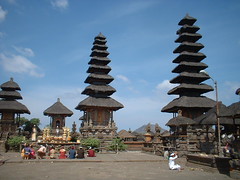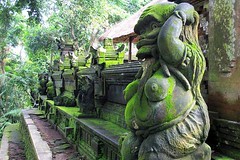Friday, July 14, 2006
Respect the temple
Bali woman adat dress consists of "Kebaya" long sleeved shirt, saput, and sarung. Senior Bali women usually wear wig and striking accessories on head, neck and wrist. Among women in Bali the most popular materials for kebaya is brocade fabric, which is semi transparent. Usually among the girls strong transparent brocade is also getting more and more popular, although protest come from older generation of Bali saying it is not polite. It is not really known, when kebaya style was introduced in Bali. Study from Bali iconography do not give any clue on this, that the style is belongs to their cultural heritage since in other areas of Indonesia Kebaya is also in use since immemorial time. It is well known that the kebaya style is belong to Malay dress style, and it was probably this type came to Bali and modified a little bit with Bali art taste. Today the use of kebaya shirt for women is even more and more popular with the availability of very thin and transparent brocades. This way of dressing has invited protest from those older people that feel this is not suitable for public areas, furthermore to be used to enter a temple. But in Bali, the tradition of religion is not as strict as other religion that give punishment to their devotee. Balinese more in the side of suggesting to wear the so called polite dress. The understanding of polite dress in Bali is that a dress that covers most of the body, but not total coverage like in Moslem does.
Among hundreds of temple in Bali, after an extensive study on the field and bibliography the important aspect of Bali temple zoning is the concept derived from original orientation, that the higher the place, the more sacred it will be. The high place in Bali is considered as the abode of the holy spirits or Dewa ( gods ). This thought has shown to us that most of the temple in Bali are located on high place, even on the peak of mountain. On the plain land where temples are laid out, this concept is translated into level of yard or using stepped pyramid. The level of the yard reflecting the level of sacredness of temple zone. Various temples in Bali showing the concept of stepped pyramid even Besakih temple is considered to have been laid out with the basic zoning concept of stepped pyramid.
* First courtyard, in Bali word it is called "jabaan" means outer courtyard. Into this area everyone can enter this yard, normally no restriction
* Second courtyard, or jaba tengah or first inner courtyard. Medium temple usually have only one courtyard. This zone is the place of people in preparing rituals materials.
* Inner courtyard or jeroan. On this zone are various shrines of gods and holy spirits.This is considered the holiest place of Bali temple.
The jaba tengah and jeroan have some strict restriction for everyone with complicated sanction for offender in the form of Bali ritual. Depending on the type of the infringement, for example, a Bali woman comes to period found to enter a temple will be fined to conduct a ritual called "mecaru". The cost of mecaru is not expensive but the ritual's procedure is complex and time consuming.
* For Balinese themselves below are restriction for entering temple.
* If one of Bali family member is dead. This restriction will continue to ban the family member to enter the temple until after certain days that have been accepted by the member of the village meeting.
* Bali woman comes to period or basically human blood can't be dropped in the temple. This has a big effect on the value of the temple, if it is found to happened a big ceremony must be conducted to clean symbolically the area.
* At some temple, child under2 years can't enter the temple, usually in the village temple called "Pura Dalem"
* In some temple in Bali strictly forbidden to enter some kind of animals, or let animal centering the temple.
* Insufficient Bali adat dress as mentioned above.
* Balinese couple just married before conducting ceremony of "mesakapan"
The peak of the temple ceremony is when the devotees ( Balinese ) are sitting together for praying, conducted by "pemangku" a Bali ritual leader. Everyone will be sitting with flower and incense in hand. During this time it is not polite to everyone to walk in front of those sitting people. If taking a photograph or seeing them is better from left or right sides. Since on their front is considered to be the empty space without any obstacle
Thursday, July 13, 2006
Ngaben, next step of life

Ngaben
Originally uploaded by BarryKusuma.
Balinese religion is based on respect for and worship of God and ancestors, and is a combination of Hindu elements and indigenous Balinese culture. After death, the body must be dissolved and returned to its original elements. The cremation ritual is a purification rite which frees the roh (soul or spirit) from its temporary earthly house and facilitates its journey to its next existence.
After a death, the whole village helps with preparations for the cremation. The mayat (dead body) is laid out in a special house to be bathed and prepared. Meals are prepared and offered to the deceased as normal. Around the body and entrance to the house are placed damar kuranung (lamps), which notify people of the death and help facilitate the soul's journey and to keep the person's memory alive.
The night before the cremation, holy water is collected from the temple and used in preparation of the body and during the cremation. Any important ceremonies which have been missed during the deceased's lifetime must be carried out prior to cremation. Some Balinese are buried until the cremation can be organised or to wait for an auspicious date. The bones are exhumed a few days before the cremation then prepared in the same way as the whole body.
All the village unites for the cremation, which is a joyous occasion. After cremation, the ashes are placed in the sea - achieving final separation of the soul from the body.
Cremation scene
The tower containing the remains is taken to the cremation ground. Depending on the size of the ceremony, either the eldest son or a priest stands on the tower holding a 'paradise bird' which will guide the spirit to heaven. At the cremation ground the corpse is placed in the carved figure of a cow (a sacred animal).Ider-ider paintings tell a story using a sequence of scenes on a horizontal strip in the style of a comic. They were tied under the eaves of temple or palace pavilions and read by walking around the building. This segment shows the cremation of Abimanyu, the heroic son of Arjuna, who died from being pierced by 100 arrows. One of his wives, Uttari, is pregnant and not permitted to join her husband in death, but his other wife Sundari leaps from the ramp into the fire, where her soul is released and flies upward in the form of a bird.
The tika is a complex 210-day-per-year calendar mainly used by Balinese ritual experts to advise the Balinese villager of the most appropriate day for undertaking any important activity, such as a cremation
In the past, an anthropomorphic (human-like) figure made from Chinese coins and cotton thread was placed lengthwise on the body after death. Called the 'measure', it ensured that after rebirth, the deceased's bones would be in the right dimensions and arrangement. Today, Chinese coins, rice and other offerings are thrown from the cremation tower as it travels to the cremation ground.


